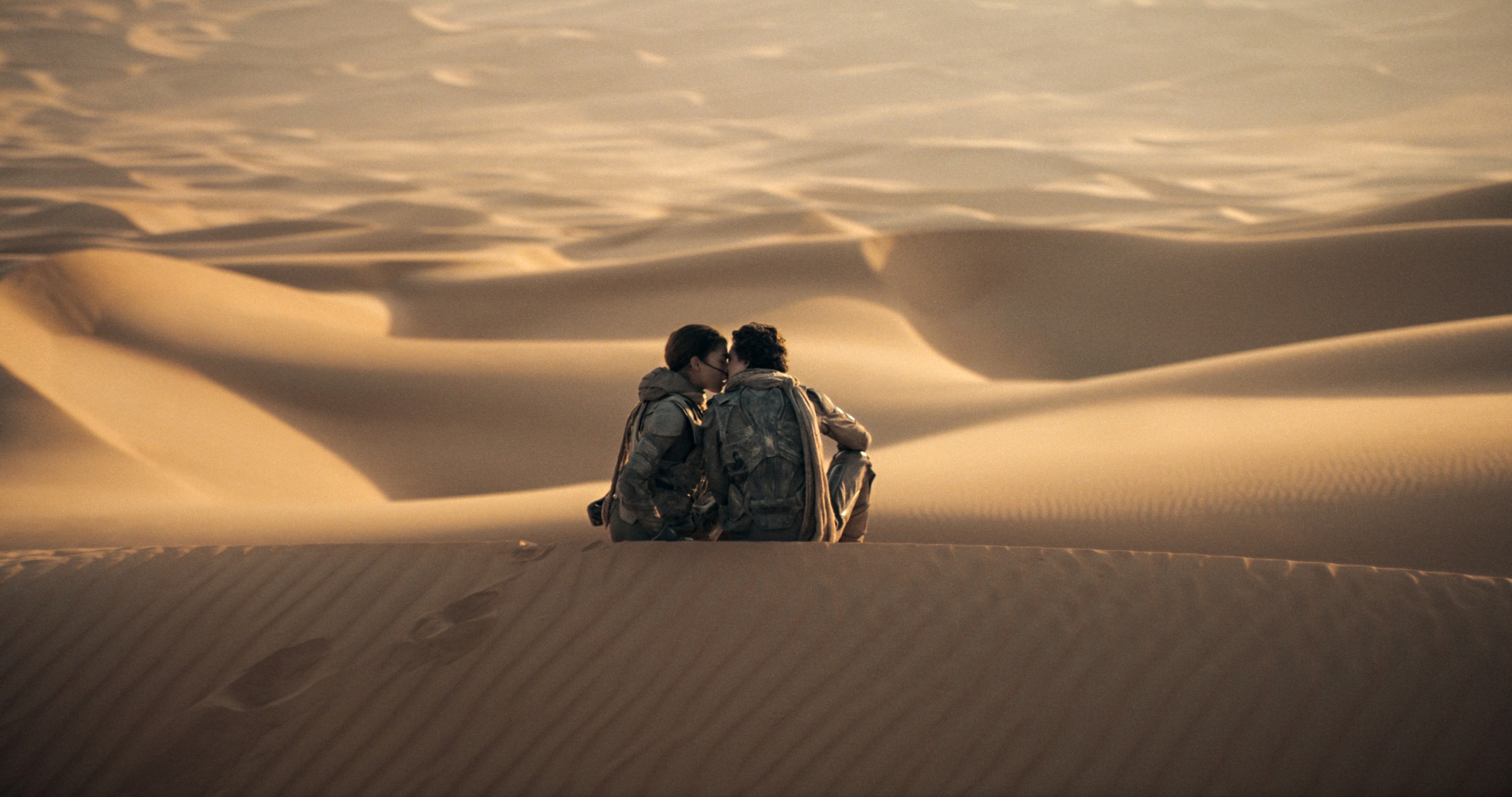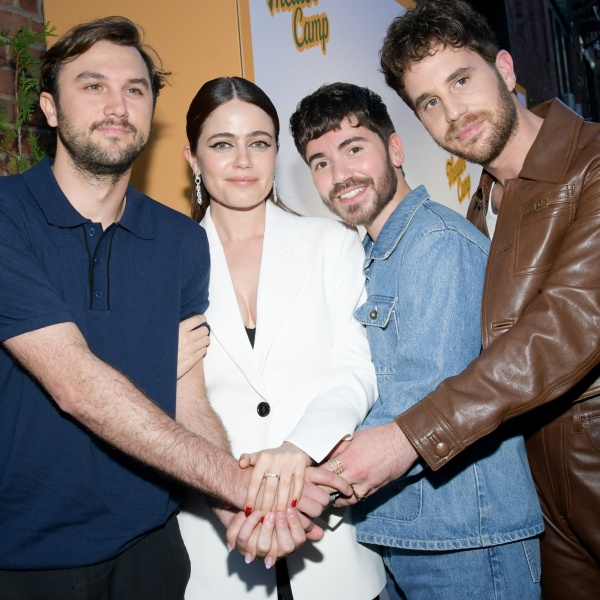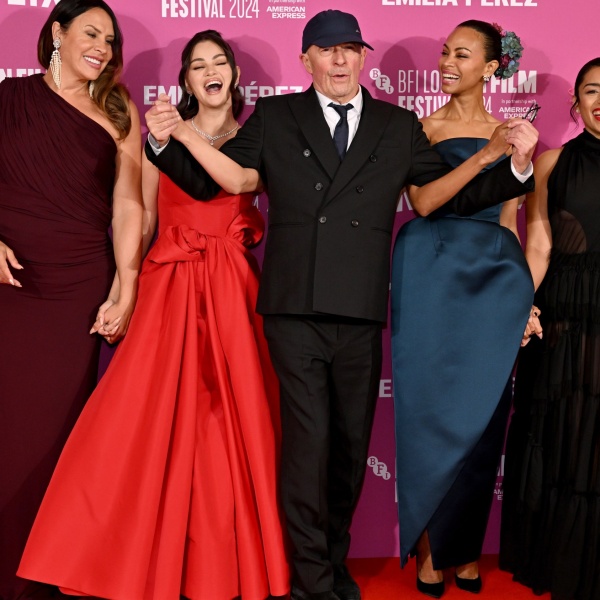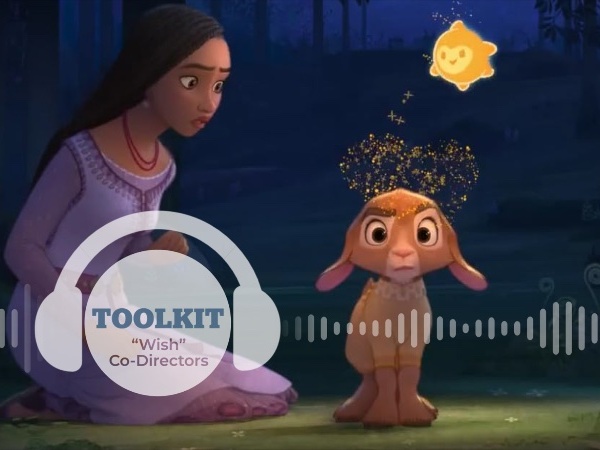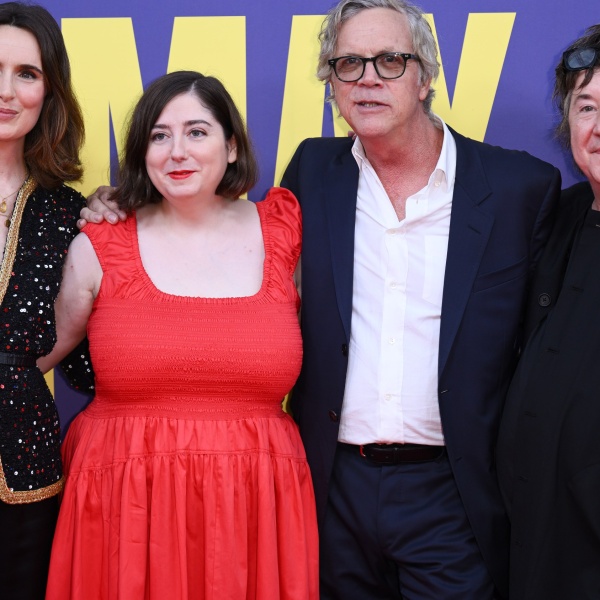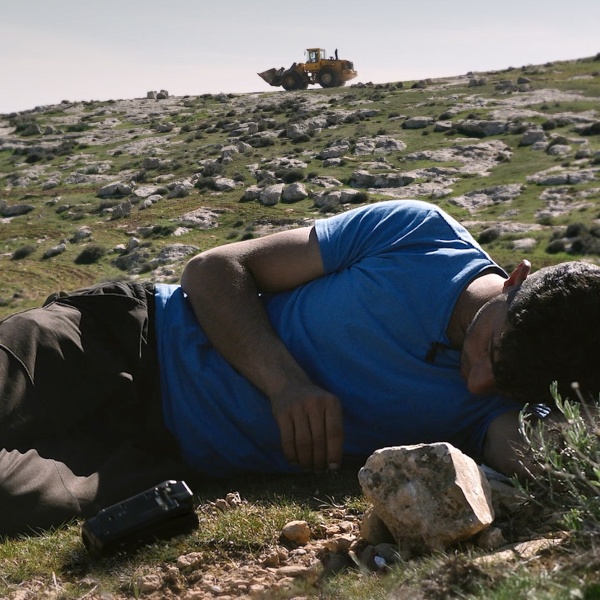Nominations voting is from January 8-12, 2025, with official Oscar nominations announced January 17, 2025. Final voting is February 11-18, 2025. And finally, the 97th Oscars telecast will be broadcast on Sunday, March 2 and air live on ABC at 7:00 p.m. ET/ 4:00 p.m. PT. We update our picks through awards season, so keep checking IndieWire for all our 2025 Oscar predictions.
The State of the Race
The early cinematography standouts are “Dune: Part Two” (Warner Bros.) and “Inside the Yellow Cocoon Shell” (Kino Lorber), while other preliminary frontrunners include “Furiosa: A Mad Max Saga” (Warner Bros.), “Civil War (A24), and “Challengers” (Amazon MGM Studios), which was shot on Kodak film along with fellow Oscar hopefuls “Kinds of Kindness” (Searchlight Pictures), “I Saw the TV Glow” (A24), “Sing Sing” (A24), “The Piano Lesson” (Netflix), “SNL 1975” (Sony Pictures), “Maria” (TBA), and “Nosferatu” (Focus Features).
“Dune” Oscar-winning cinematographer Greig Fraser returns for Denis Villeneuve’s more lavish sequel, in which Paul (Timothée Chalamet) leads the nomadic Fremen in battle on Arrakis as a prelude to their holy war. Think “Lawrence of Arabia” in space. It’s a bigger world with more planets, more set pieces, and more action. This time, the large-format film was presented entirely in the expanded IMAX aspect ratio with the Alexa mini LF and Alexa 65 digital cameras using spherical lenses.
The desert contained an expanded color palette for the immense battle sequences and the romance between Paul and Chani. The moment when Paul rides atop the sandworm for the first time to complete his Fremen rite of passage was shot practically in the desert as part of a separate “worm” unit, with Chalamet standing on a platform with gimbals and surrounded by an industrial fan that blew sand on the set. In addition, Fraser experimented with an infrared black-and-white look for the gladiator fight sequences with Feyd-Rautha (Austin Butler) on the artificial Harkonnen planet of Giedi Prime. Fraser used the Alexa 65 with special filtering and monochrome desaturation.
“Inside the Yellow Cocoon Shell” (winner of the 2023 Cannes Camera d’Or) is the remarkable feature debut of Vietnamese director Pham Thien An. The three-hour odyssey, defined by great stillness, is one of the most audacious films of the year. Unassuming Thiện (Lê Phong Vũ ) leaves Saigon with his 5-year-old nephew and returns to his country village after the death of his sister-in-law. Through a series of encounters, he starts coming out of his shell and experiences a spiritual awakening.

“Inside” was filmed by cinematographer Đinh Duy Hưng primarily in long, static shots for objective observation, but there are also sustained ethereal shots of the countryside and nature. The color palette is saturated or soft, depending on the mood. One of the highlights is an erotic flashback with Thiện’s ex-girlfriend, Thảo (Nguyễn Thị Trúc Quỳnh), on a wet balcony that explains a lot about why he moved to Saigon and why she took her vows as a nun.
“Furiosa” marks the first collaboration between director George Miller and cinematographer Simon Duggan, who brings more visual scope and dimension to the titular hero’s badass origin story (played by Alyla Browne as a child and teenager and Anya Taylor-Joy as an adult). He paired the Alexa 65 with the Arri Rental Prime DNA to help expand the Wasteland and connect it to the fortified towns surrounding the Citadel. Shooting in Australia provided a harder look than anticipated. The skies are intense, and the clouds are very defined. As far as the intense action with a lot more motorcycles, the cameras were constantly moving with the characters and vehicles, benefiting from the Edge Arm tracking vehicle and another for the crane and dolly work; then they used the Steadicam, hand-held, and rig shots when it required a more nimble touch.
With “Challengers,” director Luca Guadagnino tackles the competitive nature of tennis with a love triangle involving former tennis prodigy-turned coach Zendaya, her husband and slumping tennis champ Mike Faist, and tennis rival Josh O’Connor, who is her ex-lover and his former best friend. Shot in 35mm by Thai cinematographer Sayombhu Mukdeeprom, the movie subjectively focuses on their relationships and rivalries. While the matches reflect their changing emotional and personal dynamics, the scenes off the court achieve their own natural tension and colorful look. They storyboarded the tennis action with Brad Gilbert, the tennis consultant who coached the actors and choreographed the action. The tennis was about camera speed and dexterity. The lighting team even came up with an inspired solution to cover the court and grandstand: a pair of Magni scissor lifts with two 100K SoftSuns on each. However, the final 10 minutes utilize a glass floor to enable a partial view of the players in constant motion.
Alex Garland’s “Civil War” is a surreal road trip through the dystopian nightmare of guerilla warfare that rips the country apart and culminates with the final assault on D.C. and The White House. Cinematographer Rob Hardy creates an authentic-looking combat aesthetic based on newsreel footage and real combat photography, which mostly avoids tracks and dollies in favor of elegant hand-held shots. In fact, they reversed engineered sequences that were adaptable to sequences that were planned as military operations. Additionally, they cunningly used still photography cutaways by jaded combat photographer Kirsten Dunst and aspiring photographer Cailee Spaeny, who play out an “All About Eve” dynamic.

Yorgos Lanthimos’ “Kinds of Kindness” is a triptych fable about the loss of free will set in alternate realities, with a cast led by Jesse Plemons, Emma Stone, and Willem Dafoe. What links the three chapters — “The Death of R.M.F.,” “R.M.F. Is Flying,” and “R.M.F. Eats a Sandwich” — is the presence of the silent, bearded R.M.F. (Yorgos Stefanakos). Shot by go-to cinematographer Robbie Ryan in 35mm (using black-and-white for dream sequences), the black comedy is a far cry from “Poor Things” and “The Favourite,” with their ultra-wide camera angles and tight framing. The director recommended anamorphic lenses, which were a good fit for the American setting and introspective tone, with characters often isolated in empty rooms.
“Blitz,” (Apple TV+) from British director Steve McQueen, concerns Londoners during the Blitz of World War II, and stars Saoirse Ronan, Elliott Heffernan, and singer/songwriter Paul Weller in his acting debut. It centers on youngster Heffernan, sent to the countryside for safekeeping, who’s determined to reunite with his mother (Ronan) and grandfather (Weller) at their home in London. It’s shot by French cinematographer Yorick Le Saux and follows McQueen’s acclaimed World War II doc, “Occupied City,” which provided the director with an understanding of the detailed atmospherics of war that he could apply here.
“I Saw the TV Glow” marks the latest meta-cultural exploration of suburban teen angst by director Jane Schoenbrun. Set in the late 1990s to 2000s, the horror film follows Owen (Justice Smith) and Maddy (Brigette Lundy-Paine), who bond over their love over the late-night kid’s show “The Pink Opaque” and slowly realize that the show’s bizarre reality has overtaken their own after its cancelation. Shot in 35mm by cinematographer Eric K. Yue, the look contrasts a grim reality with a cotton candy-like hyper-reality as a glimmer of hope.
“Megalopolis,” Francis Ford Coppola’s $120 million epic sci-fi passion project drawing parallels between the fall of Rome and the collapse of America, is set in a New York-like metropolis called New Rome. After an accident destroys the decaying city, an architect (Adam Driver) with the power to control time attempts to rebuild it as a utopia despite regressive opposition. The film was shot by the director’s frequent cinematographer, Mihai Mălaimare Jr., with the Alexa 65 and Alexa LF (and Alexa Mini LF for second unit) to convey something radically different: imagery that is more metaphorical by design with the look of a woven mural or tapestry.
“Sing Sing,” director Greg Kwedar’s fact-based drama about a theater troupe of inmates at Sing Sing, led by Colman Domingo, was filmed inside the correctional facility. Cinematographer Pat Scola shot the film in gritty 16mm with the Arri 416 and Arri SR3 to capture the grounded authenticity of the environment and the visceral, free-wheeling quality of the performances, mainly spent rehearsing the epic time-traveling farce “Breakin’ the Mummy’s Code.”
As for the rest: “Gladiator II” (Paramount), Ridley Scott’s sequel to his Oscar winner, concerns Lucius (Paul Mescal), the former heir to the Empire, forced to enter the Colosseum after his home is conquered by the tyrannical emperors who now lead Rome. The epic is shot by cinematographer John Mathieson, who began his collaboration with Scott on “Gladiator,” with even greater grandeur.
“Joker: Folie à Deux” (Warner Bros.), Todd Phillips’ musical-thriller, finds Joker Joaquin Phoenix striking up a romance with Lady Gaga’s musical therapist, Harley Quinn, while incarcerated in Arkham Asylum. They experience musical madness through their shared delusions as Joker plots his escape to start his criminal empire. Oscar-nominated “Joker” cinematographer Lawrence Sher returns with visual inspiration from Coppola’s “One From the Heart.”
“The Piano Lesson,” adapted from the August Wilson play, explores the lives of the Charles family in 1936 Pittsburgh and the importance of the cherished family heirloom: a piano carved by an enslaved ancestor. Directed by Malcolm Washington and starring John David Washington and Samuel L. Jackson, the movie is a film-digital hybrid shot by cinematographer Michael Gioulakis.
“Conclave” (Focus Features), director Edward Berger’s follow-up to his Oscar-winning “All Quiet on the Western Front,” is a thriller adapted from the Robert Harris novel about a Cardinal (Ralph Fiennes) tasked with finding a successor to the deceased Pope, who harbored a dangerous secret. The film is shot by French cinematographer Stéphane Fontaine (“Jackie”).
“Maria,” Pablo Larraín’s biographically-inspired drama about opera singer Maria Callas (Angelina Jolie), takes place during her final years in Paris in the ’70s. It continues the director’s cycle of psychological portraits (“Jackie,” “Spencer”) and contains a visual concept that fuses the ’40s through the ’70s period with surreal musical sequences. It’s shot in both 16mm and 35mm by Oscar-nominated cinematographer Ed Lachman (“El Conde”).
“SNL 1975,” from director Jason Reitman, chronicles the lead-up to the premiere of NBC’s iconic late-night sketch comedy show. Gabriel LaBelle pivots from playing Steven Spielberg in “The Fabelmans” to “SNL” creator/producer Lorne Michaels, sharing the spotlight with an ensemble cast portraying the legendary comedy troupe that became famous on the show. The film was shot in 16mm to authenticate the period vibe by Reitman’s go-to cinematographer, Eric Steelberg.
“Nosferatu,” director Robert Eggers’ passion project, is a reworking of the legendary silent vampire film by F.W. Murnau (later remade by Werner Herzog in 1979) and stars Bill Skarsgård as the infamous Count Orlok, Lily-Rose Depp as Ellen Hutter, and Nicholas Hoult as her husband, Thomas Hutter. Shot in 35mm by the director’s frequent cinematographer Jarin Blaschke, the film boasts a desaturated look reminiscent of 19th-century Romanticism.
“Wicked” (Universal), Jon M. Chu’s adaptation of the Broadway musical fantasy by Stephen Schwartz and Winnie Holtzman, uncovers the rivalry between the Wicked Witch of the West and Glinda the Good Witch that began when they were teens. Cynthia Erivo stars as Elphaba Thropp, the misunderstood girl born with green skin, and Ariana Grande plays the popular Galinda Upland. Made at England’s new Sky Studios in Elstree, the musical reunites Chu with rising cinematographer Alice Brooks, who last collaborated together on “In the Heights.” But this colorful, hyperreal extravaganza is definitely a horse of a different color.
Potential nominees are listed in alphabetical order; no film will be deemed a frontrunner until we have seen it.
Frontrunners
“Challengers” (Sayombhu Mukdeeprom)
“Civil War” (Rob Hardy)
“Dune: Part Two” (Greig Fraser)
“Furiosa: A Mad Max Saga” (Simon Duggan)
“Inside the Yellow Cocoon Shell” (Đinh Duy Hưng)
Contenders
“Blitz” (Yorick Le Saux)
“Conclave” (Stéphane Fontaine)
“Gladiator II” (John Mathieson)
“I Saw the TV Glow” (Eric K. Yue)
“Joker: Folie à Deux” (Lawrence Sher)
“Kinds of Kindness” (Robbie Ryan)
“Maria” (Ed Lachman)
“Megalopolis” (Mihai Mălaimare Jr.)
“Nosferatu” (Jarin Blaschke)
“The Piano Lesson” (Michael Gioulakis)
“Sing Sing” (Pat Scola)
“SNL 1975” (Eric Steelberg)
“Wicked” (Alice Brooks)
